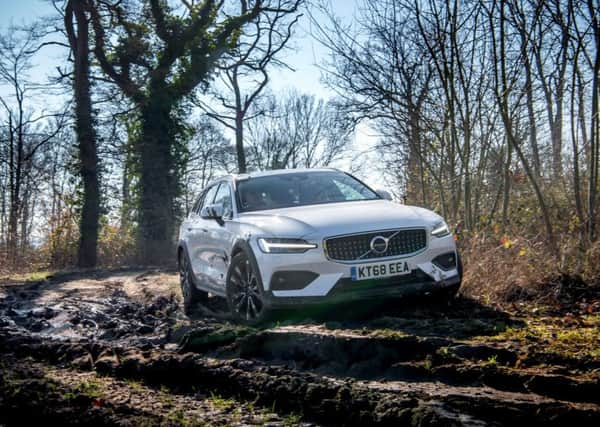Review: Volvo V60 Cross Country Plus


On 4 January it reported record annual sales in 2018, passing the 600,000 mark. UK sales reached beyond 50,000 for a 28-year high. Its XC40 small SUV had been voted European Car of the Year and the XC60 went one better, as world car of the year. In the UK alone Volvo won 43 awards including brand of the year from the consumer champions, Which?
In February came news of its “mild” hybrid diesel and petrol engines and the promise of plug-in (mains-charging) hybrids across all models.
Advertisement
Hide AdAdvertisement
Hide AdMarch brought the news that all its cars would have a top speed limited to 112mph from 2020, the year it hopes no one will be killed or seriously injured in a new Volvo. World sales were up 11 per cent as UK sales of the S60 saloon started. It is the first modern Volvo to abandon diesel engines. It announced its standardised “care key” for 2021 which will allow owners to set a top speed for drivers. Other safety measures for the cars will be camera monitoring for drowsiness, drugs or drinking. At the end of the month it confirmed it would be the vehicle supplier for the British Triathlon officials.
On 5 April Volvo UK reported its best-ever first quarter sales. To meet unexpected levels of demand, Chinese production of the XC40 began near Shanghai. Hazard and slippery roads warnings from car to car via the “cloud” were announced across Europe for new models next year and retro-fitting on some older cars. But first quarter operating profits were down 19 per cent despite increased sales and net revenue after higher tariffs and “price pressure” in many markets.
In May it offered six-month parental leave on 80 per cent pay for sales employees in Europe, the Middle East and Africa. Owners voted Volvo the most dependable premium brand in the annual JD Power survey.
In June, with helmet maker POC, it started tests of cyclist head impact on different parts of a car to get safer helmets and improve car design. Volvo Cars is joining with other car makers, “service providers” and governments in a European pilot project to share traffic safety data generated by cars and infrastructure, in the “interest of safer roads for all”. It also showed a self-driving car which it is developing with the taxi firm Uber. It claims to have immediate intervention if steering, braking and other key systems were to fail, halting the car.
It went on to announce a high-protection armoured version of the XC90, with 10mm-thick bodywork by TRASCO Bremen, Germany. It weighs 1,400kg more than the standard car.
Until this apparently unstoppable future arrives, Volvos remain much as we know them: conventional, strong, refined, a credible alternative to a Jaguar, Lexus and the familiar German trio of Audi, BMW and Mercedes-Benz.
Its ace card is the so-called SUV, more accurately variations on the estate cars for which Volvo made its name last century. Semantics beg the question as to when an estate car becomes an SUV, once the domain of lumbering off-roaders. Its largest model, the XC90 makes the SUV grade. Maybe, too, the XC60.
I have spent the week with the V60 Cross Country, nearer the sleek V60 estate than the XC60, which has a bulkier body. It looks much like the regular V60 but its USPs are 60mm or 2.3 inches more ground clearance and black protective edges to its wheel arches and flanks. All-wheel-drive and hill descent control handle the slippery bits.
Advertisement
Hide AdAdvertisement
Hide AdAffordable? Prices start at £39,935 for the T5 automatic: a 246.5bhp 2-litre petrol turbo rated at 186g of CO2. My test car was the other model, the 187bhp D4 turbo diesel. At £40,435 it promises cheaper ownership, rated at 143g CO2 and 43 to 48mpg depending on wheel size. The kit list features “bending” and adaptive headlights, cornering angles for the front fog lamps, all of which could be useful in the dark depths of cross country motoring.
The reality is that it will be bought by people who like its subtly tougher demeanour and ability to temper winter weather without resorting to the heft of the XC60. If you like – the traditional Volvo types, with or without Labradors in the back.
As an everyday car I liked it. The “touring” chassis suspension is firm but keeps noise from the large tyres subdued. The navigation was accurate – displayed on a vertical central screen with a next-turn diagram on the left to keep your navigator informed of what’s coming. A smaller display and next-turn notation are shown behind the steering wheel.
The diesel engine is not too rowdy and pulls well – this will be the choice for Volvo People Who Tow. Running unloaded, the V60CC averaged between 39 and 44 miles a gallon. Being a new model, it faces no discrimination in city clean-air zones.
There is hands-free opening of the tailgate but it does not have load-bay latches to flatten the rear seats. Another niggle was tight entry to those rear seats.
Verdict: A fine, smart all-roader from a company which is blooming. The interior is charming.